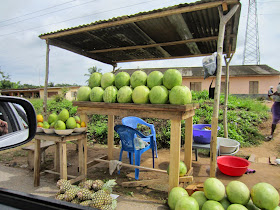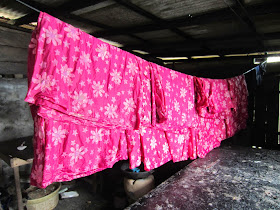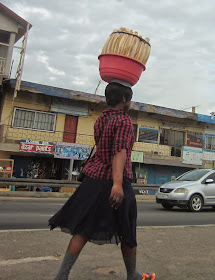As most trips are, our trip to Ghana was a huge perception changer for me.
The Republic of Ghana, known as the Gold Coast from 1867 to 1957 when it was a British colony, is a country in West Africa bordered by Cote d'Ivoire to the West, Burkina Faso to the north, and Togo to the east, three countries I knew nothing about (and still know very little about) and could not have pinpointed on a map before this trip. Ghana is just a few degrees north of the equator and has a tropical (read: hot and muggy) climate. The word "Ghana" means "warrior king."
I have to admit that it's taken me a while to get used to the idea that the Ghana coast faces south, not west. Even while there, as we looked out over the ocean at night, I imagined I was directing my gaze towards the the Americas, not Antarctica.
I also used to think that West Africa referred to the entire west coast of Africa. Wrong. It's only the southern part of the big bump at the top of the continent.
About the size of the state of Oregon, Ghana has about 27 million people compared to Oregon's 4 million. (The two largest cities, Accra at 2.3 million and Kumasi at 2 million, together have more people than all of Oregon.)
As the first African nation to declare independence from colonization, Ghana had a significant impact on the liberation of other African nations and on Black Pride movements in the United States. During the first decade of Ghana's independence, many African Americans--including Malcolm X, Maya Angelou, Richard Wright, Muhammad Ali, and Martin Luther King, Jr.--settled in or made a pilgrimage there, and when they returned to the United States, they brought new attitudes and expectations with them.
As far as West African nations go, Ghana has a pretty strong economy. So how does living in Ghana compare to life in the United States?
Well, according to
this site, if you live in Ghana, you will:
• be 8.1 times more likely to die in infancy
• be 3.2 times more likely to have AIDS
• have twice as many babies
• use 98.12% less electricity
• make 96.77% less money
• consume 96.34% less oil (although we would have never guessed that based on the
traffic jams in Accra)
• die 17.69 years sooner
• spend 98.87% less on health care
• have an 18.28% greater chance of being unemployed
• experience 12.44% less of a class divide
This is shocking enough, but then try comparing Ghana to other nations, like Kenya, where the likelihood of having AIDS is 3.5 times higher than it is in Ghana and the chance of being unemployed is 3.6 times higher, among other issues.
(Try playing around with
this site. It is really enlightening.)
We spent our five days in Ghana on the southern coast. My husband Bob is a descendant of Captain George Cannon, a slave trader from the Isle of Man, and Bob has been researching Captain Cannon for at least the last ten years. Captain Cannon was active in slave trading from 1790 to 1803 and took six or seven slave voyages to Africa during that time. Bob has been able to discover some of the ports where Captain Cannon acquired slaves, facts that had been unknown prior his research, and the opportunity to visit those areas was both exciting and sobering.
Bob and Russ planned a drive that would include six "slave castles," or large forts built by European traders for the purpose of holding slaves until they were loaded into the keels of ships for transfer to the Americas. Captain Cannon had visited at least two of them.
We would be trading our photography of wild animals roaming free on Africa's East Coast for pictures of places where men and women were imprisoned in horrible conditions on Africa's West Coast, a journey from awe to awful.
READING:
.jpg)
The most famous Ghanaian of my lifetime is probably Kofi Annan, who was born in 1938 in Kumasi, Ghana, received an economics degree at Macalester College in St. Paul, Minnesota, studied in Geneva, Switzerland, and received a master's degree from MIT's Sloan School of Management. I'm pretty sure that is an unusual trajectory for a Ghanaian, but Kofi Annan is an unusual man. The reason most of us have heard of him is because he was the seventh Secretary-General of the United Nations (January 1997-December 2006). He and the United Nations were jointly awarded the Nobel Peace Prize in 2001 for "their work for a better organized and more peaceful world." As Secretary-General, Annan focused on advocating for human rights, containing the spread of HIV in Africa, and strongly opposing international terrorism.
Since retiring from the UN, Annan has joined a group called
The Elders, an organization formed by Nelson Mandela in 2007 and comprising elder statesmen, peace activists, and human rights advocates. The group includes former President Jimmy Carter, several other Nobel Peace Prize laureates, former presidents of Brazil, Finland, Ireland, and Mexico, and other distinguished world leaders. These seasoned men and women work to promote dialogue and human rights around the world.
I heartily recommend
Kofi Annan: A Man of Peace in a World of War by
Los Angeles Times foreign and diplomatic correspondent Stanley Meisler. Meisler traces Annan's rise to power on the international stage and his impact on the image and influence of the United Nations. Annan was the first Secretary-General to rise up from within the ranks of the UN, and his experience gave him unique insights into how the UN functions.
Meisler does not make Annan a saint. His weaknesses are discussed along with his strengths, but it is impossible not to be impressed by this gentle, honest man. I was especially impressed by Annan's integrity, even when making the right choice was unpopular and had a significant negative impact on how he was perceived in the international community. For example, the G. W. Bush years of war in Iraq (with which he strongly disagreed) were very hard on his reputation. He was disliked in the United States for his opposition to the war, and criticized by the international community for not being able to prevent the war.
I learned a lot about the UN, both its history and its current position in the world, and I will be much more likely to pay attention to its role in world affairs after having read this biography.
Here are a few quotes (not necessarily from the book) from this amazing man:
Suffering anywhere concerns people everywhere.
What governments and people don't realize is that sometimes the collective interest--the international interest--is also the national interest.
If one is going to err, one should err on the side of liberty and freedom.
Education is a human right with immense power to transform. On its foundation rest the cornerstones of freedom, democracy, and sustainable human development.
Gender equality is more than a goal in itself. It is a precondition for meeting the challenge of reducing poverty, promoting sustainable development and building good governance.
To live is to choose. But to choose well, you must know who you are and what you stand for, where you want to go and why you want to get there.











.JPG)



.JPG)
.JPG)
.JPG)





.JPG)

.JPG)




.gif)
.jpg)










